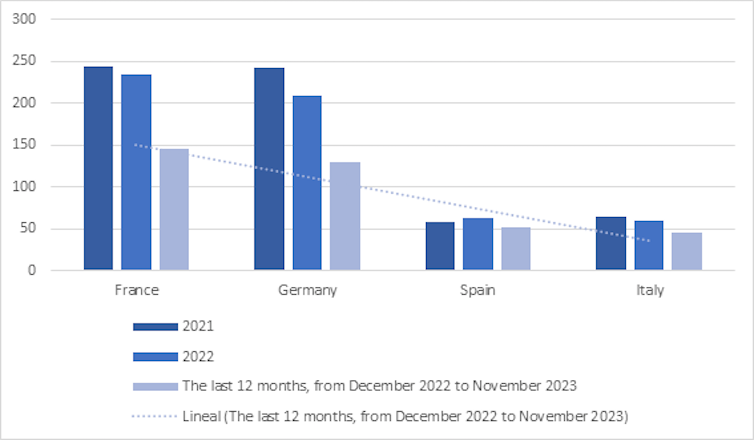Press play to listen to this article
Voiced by artificial intelligence.
By GEOFFREY SMITH
with JOHANNA TREECK, BEN MUNSTER, HANNAH BRENTON, GIORGIO LEALI and IZABELLA KAMINSKA
— “All systems go” at the BoE as the Old Lady probes into the deepest and darkest crevices of the financial system to better detect risks.
— The European Commission’s long awaited proposals for a legal framework for a digital euro are delayed once again.
— Bank of Finland’s Olli Rehn outlines why he thinks the financial system is still prone to lower rather than higher rates.
ECB 3.50% ⇡ — BOE 4.5% ⇡ — FED 5.25% ⇡— SNB 1.5% ⇡— BOJ -0.10% ⇣— RBA 4.10% ⇡— PBOC 3.65%⇣— CBR 7.5% ⇣ — BOC 4.75 ⇡— SARB 8.25% ⇡
Good morning. It’s the day of the Great Exception: by the time you open this, the People’s Bank of China will probably have cut its benchmark one- and five-year lending rates, in line with the 0.10 percent adjustment to its shorter-term repo rates in recent weeks, and in stark contrast to most other central banks across the world.
The market reaction ought to be modest: it’s already clear that Beijing is trying to stimulate demand as its export industries find that western societies’ demand for its goods withers with the spending of the last pandemic savings. Exports were down 7.5 percent on the year in May, while producer prices were down 4.6 percent.
Worse, there are increasing suggestions of substantial structural problems: with the workforce already shrinking, youth unemployment should not be over 20 percent. Over the labor day holiday weekend, Chinese consumers made 19 percent more trips than in 2019, but spent only 0.7 percent more, according to the Center for Strategic and International Studies’ Qin Mei. That doesn’t seem like the kind of thing that monetary stimulus will do much to cure.
In Europe, the opposite is true. Labor markets are tight as a drum and the fear of unemployment is low — one reason why consumption is responding more slowly than expected to past interest rate hikes. The pass-through is coming alright — U.K. two-year mortgage rates hit 6 percent last week, meaning that anyone forced to refinance a loan taken in 2021 is likely to face an annual hit of £3,000 to disposable income, according to some estimates. But, as the ECB’s Isabel Schnabel pointed out on Monday, it’s just taking too damn long for comfort, and the longer it goes on, the higher the risk that expectations get de-anchored.
Send tips to [email protected], [email protected], [email protected], [email protected]. Tweet us, too: @Geoffreytsmith, @JohannaTreeck, @Ben_Munster, @izakaminska
— ECB’s Enria set to warn again on nonbank exposures, 10 a.m.
— Central Bank of Hungary policy decision, 2 p.m.
— U.S. May housing starts and building permits, 2:30 p.m.
ENRIA TO PUSH ON NONBANK LINKAGES: The EU’s top banking supervisor Andrea Enria will today push the eurozone’s biggest banks to improve how they manage their counterparty credit risk, after the collapse of the Archegos hedge fund showed how losses in the nonbank sector can spread to lenders.
Risky business: The ECB’s supervisory arm has already set out expectations for banks to regularly stress test their exposures to nonbanks to manage the risk that the other side of a derivatives or securities-financing trade goes bust. Today, it’s inviting the banks under its watch into its headquarters in Frankfurt to drive home its concerns during a conference on counterparty credit risk. Enria’s warnings about risky exposures have become more frequent as the ECB’s monetary policy setters raise rates to a level where something is likely to break, triggering contagion across the financial system.
EASING IN THE AIR: The Chinese moves overnight are likely to dominate early trading in markets, with any hint of further easing likely to push the offshore yuan in the direction of a new high for the year. In Europe, meanwhile, Hungary kicks off a string of monetary policy decisions, with markets primed for the National Bank of Hungary to replicate last May’s 100 percentage point cut in a critical one-day deposit rate, which was introduced as an emergency measure last October. The move would take the effective rate to 16 percent.
Analysts at ING believe the MNB will underscore the acceleration of disinflation as a significant factor in its decision to keep easing, but also that the Monetary Council will refrain from offering any substantive comment on a possible cut in the base rate soon. That stands at 13 percent.
In the U.S., housing starts and building permits data for May are due, with the potential to extend a series of upside surprises.
ONE STEP BEYOND: The Bank of England is also trying to get ahead of the next financial crisis. It said on Monday that it will begin a “system-wide exploratory scenario” (SWES), aimed at finding vulnerabilities in the financial system outside its traditional remit of the banking sector. The survey will cover insurers, central counterparties, pension funds, hedge funds, and funds managed by asset managers.
Full throttle: Ever since they near-throttled the life out of banks with the Basel III rules, regulators have been obsessing over the new hiding places for risk and recklessness in the financial system. Their concerns have multiplied as zero interest rates and financial repression have forced institutions into ever-more ingenious ways to earn a bonus, er, living.
LDI trauma: Nor are such fears unjustified. The initiative is largely a response to the meltdown in the Gilt market last September, when a sharp rise in yields in response to a highly expansive budget from the Conservative government triggered a vicious circle of selling by pension funds using so-called ‘liability-driven investment’ strategies, or LDI. That exposed all manner of fragilities that the Bank hadn’t grasped. The Bank will publish a full list of participants and details of the stress scenario later this year, and will release its findings in 2024. For more on the story see here.
DIGITAL EURO PROPOSAL DELAYED (AGAIN): The European Commission has again put off publishing its proposals for the legal framework to underpin the digital euro, according to a legislative agenda obtained by Bjarke on Morning Financial Services.
Unknown reasons: The bill was due June 28, after already being postponed once earlier in the spring. The decision surprised officials within the industry and the Commission itself, as the legal text had been agreed at a technical level within the Berlaymont. No new date has been suggested for the digital euro and an accompanying bill on legal tender.
Watch this space. The proposals are controversial with many bankers, who fear savers might prefer to hold digital euros than keep their money in bank deposit accounts. The delay may be related to scheduling. Four financial bills were planned for June 28, including a proposal for payment services and another on data exchange within the sector.
CRYPTO MUSCLES IN ON CBDCs: Central bankers will tell you that the fad for central-bank-issued digital currencies is, if anything, a reaction to the threat posed by cryptocurrencies to good, technocratic monetary policy. But don’t tell that to Ripple Labs, Inc. The one-time crypto wunderkind (currently embattled in a legal case with the U.S. Securities and Exchange Commission over whether its tokens are really securities since 2020) is positioning itself as a builder of CBDC blockchain infrastructure, with a surprising degree of success. Or so, at least, it says.
ColombiCoin: Ripple’s central banking lead, James Wallis, told Morning Central Banker that the company was able to woo the Bank of Colombia to join the ranks of other C-list cbanks, such as the Montenegrin central bank, trialing its blockchain-based “CBDC platform,” thanks to the reputation it had amassed as a digital currency expert when rolling out its cross-border payments network. Wallis wouldn’t confirm, however, whether Ripple would actually be paid for these services, strongly implying that the company’s main source of revenue remains the sale of its pre-existing and closely held tokens in the marketplace.
It may seem odd that a crypto company like Ripple might want to empower the state’s official strike back against crypto, but Ripple was never a company that wanted to distance itself from the incumbent system. Rather, its executives were often seen pandering to the prevailing order at places like Davos, reinventing themselves whenever necessary to stay relevant.
Yet another pivot: Ripple’s latest reinvention sees its taking advantage of the ambiguous overlap between CBDCs and crypto by pitching largely unremarkable tech fixes with a covert crypto spin. Ostensibly Ripple is peddling a blockchain, but it’ll almost certainly be less like Bitcoin or Ethereum and more like a shared Google Sheets doc accessible to a narrow band of central bankers. Wallis prefers to see it as powering an otherwise traditional banking superstructure of mortgages and loans with “third-party platforms” that offer things like “tokenized real estate” and CBDC-lending.
Crypt-omens. While that fuzziness might help dispel some of the stigma, it’s hard to imagine stalwart institutions like the Bank of England — which has pretty much ruled out crypto — getting on board. But Wallis says outside the big skeptical Western countries there is optimism around blockchain, and he predicts that “most” CBDCs will end up using the tech in some form. That could prove self-fulfilling if banks start to believe the two are one and the same.
BAD NEWS, INFLATIONISTAS! Olli Rehn, governor of the Bank of Finland, is not convinced current high inflation rates necessarily imply a fundamental shift in the prevailing low-interest rate paradigm — a.k.a the “natural interest rate” and/or r* — which remains influenced by engrained structural factors and secular stagnation. “Transitory high inflation and a structurally low r* can coexist,” Rehn told a Cbank conference in Helsinki on Monday, pouring cold water on the idea the system had entered an extended high inflationary period.
Transitory is still a thing: To Rehn’s mind, “even though it may be tempting to extrapolate the current situation to the future, we cannot assume that it automatically marks the end of the long-standing secular decline of the natural rate,” he said. Among the factors that imply r* is far lower than people appreciate include ongoing demographic change, an increase in inequality and the slowdown in productivity growth. “These demonstrate that the secular drivers of r* are inherently structural, which is why a major reversal in just a few years seems unlikely,” he said.
You can see the computer age everywhere but in the productivity statistics: There were hopes, Rehn noted, that Covid might increase digitalization and thus boost productivity, but this seems not to have been the case. “While the use of digital communication technologies and remote work has indeed transformed working life, the productivity effects of these changes are currently assessed to be rather small,” he said.
He acknowledged, though, that with AI things could go either way. On one hand, the technology has immense potential to boost productivity. On the other hand, if workers are displaced in a way that boosts inequality, AI’s impact “could further weigh on the natural rate,” Rehn said.
Mean reversion: If Rehn is right, the natural level for advanced economies is closer to 1 percent, meaning current high inflation rates should not last long. At worst, “short-run transitory forces … and long-run secular drivers, on the other hand, are pulling r* in opposite directions,” he said.
FRANCE GETS THE MEMO: French Economy and Finance Minister Bruno Le Maire pledged to cut at least €10 billion from public spending over the next year, in an effort to put the budget back on a more normal footing after the shocks of the pandemic and Russia’s invasion of Ukraine.
Fuel subsidy phase-out: Le Maire told lawmakers in Paris that France will phase out by 2030 existing tax perks for the fossil fuel sector, notably with regard to gasoline and to agricultural use of diesel. He’s also cracking down on government reimbursement of health costs and reducing state support for professional training, given the low ongoing rate of joblessness.
Protect the rating: In April, Le Maire pledged to bring the budget deficit down to 2.7 percent and government debt to 108.3 percent of GDP by 2027, but that didn’t stop Fitch cutting the country’s credit rating a few days later. Standard & Poor’s however decided against a downgrade a few weeks ago.
CUCKOO TIME: Markets are bracing for a half-point hike in interest rates from the Swiss National Bank when it meets on Thursday, as President Thomas Jordan continues to grapple with a sticky inflation rate. Swiss headline inflation was up 2.2 percent year on year last month, which sounds not bad at all until you realize the SNB’s target is actually zero to 2 percent, not 2 percent as it is in most other places.
The hike, which would be conspicuously bigger than anything from any other reserve currency central bank this month, is largely driven by a desire to keep the Swiss franc strong to avoid importing inflation, according to analysis by Martina Honegger-Romahn at Allianz Global Investors.
“Due to the widening yield differentials to German Bunds and recent hawkish monetary-policy actions from the Canadian, Australian and EU central banks this has become increasingly challenging,” she wrote to clients on Monday.
Call that a fix? The SNB has a general capacity to stay hawkish for longer too because the vast majority of Swiss mortgages aren’t just fixed, they’re fixed about 10-15 years.
Domestic vs external inflation: As to why the Swiss wouldn’t prefer to keep unwinding their massive balance sheet instead of raising rates? Honegger-Romahn said the mechanism was better reserved for combating external inflation pressures. “Interest rate hikes are generally more effective when it comes to taming domestic inflationary pressures – which are currently the SNB’s prime concern,” she said.
“But we are where we are now, we got a lot of hiking already done. It’s not the case that we need to kind of provide a lot of forward guidance … At this point we’re, we’re much more purely, truly data driven,” said ECB chief economist Philip Lane, when asked at a conference in Madrid about the likelihood of further hikes beyond July.
“Fiscal policy is expected to tighten over the projection horizon. However, only about half of the discretionary stimulus provided in response to the pandemic and the energy shock is expected to be reversed by 2025,” said ECB board member Isabel Schnabel, in a speech in Luxembourg on Monday.
“There is no doubt inflation will ease … Underlying prices, however, could face more limitations in that slowdown,” said ECB VP Luis de Guindos at a prize giving ceremony in Madrid on Monday.
— The legacy of Arthur Burns and its implications for macro policy today (Mercatus)
— Tech-Stock boom pits AI against the Fed (WSJ)
— Sweden’s Property crunch worsens as another firm cut to junk (Bloomberg)
(Editor’s note: this is intended as a selective list, giving precedence to European events)
People’s Bank of China, loan prime rate decision, 3:15 a.m.
Japan April industrial production, capacity utilization, 6:30 a.m.
Germany May PPI, 8 a.m.
ECB Supervisory Board head Andrea Enria speaks at Frankfurt conference, 10 a.m.
Bank of Finland Governor Rehn presents on economic outlook, 10 a.m.
Eurozone May balance of payments 10 a.m.
Eurozone May investment fund statistics, 10 a.m.
Eurozone April construction output 11 a.m.
Central Bank of Hungary policy decisions, 2 p.m.
St. Louis Fed President James Bullard speaks, 12:30 p.m.
U.S. May housing starts, building permits, 2:30 p.m.
ECB weekly financial statements and APP/PEPP updates, 3 p.m.
ECB Supervisory Board member Elizabeth McCaul gives keynote speech on “The future of globalization: politics, business, lifestyle, brands” at U.S.-Italian event, n.a.
NY Fed President John Williams speaks, 5:45 p.m.
Bank of Spain Governor de Cos, ECB VP de Guindos participate at the German Bernacer prize ceremony in Madrid, 7:10 p.m.
All times CET unless otherwise stated.




